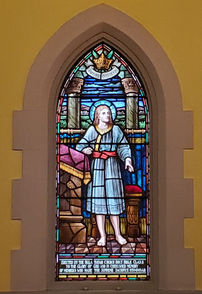The windows of St. John’s Church are a treasure, and a bit of a secret. Given as memorial gifts over the past century, they are of remarkably consistent style, and together present a composite picture of the life of Jesus.
In 2002, the congregation of St. John’s agreed to a radical colour scheme for the interior or the church, to better draw attention to the windows.
"Stuart Reid, the stained glass artist who selected the colours, writes of the St. John’s windows: 'Most of your windows are in the typical 19th century style; deeply saturated colour, dawn or evening settings, muted green grey borders with golden stain and black enamel to give nuanced detail to everything from inscriptions to architectural canopies. The early McCausland style is derived from the marriage of the Arts & Crafts Movement with the romantic sensibilities of the Pre-Raphaelites, made possible through the legendary teamwork or Sir Edward Burne-Jones and William Morris. These two artists set the standards for ecclesiastical stained glass in the last half of the 19th century right up to the First World War, (and in the colonies, where tastes were more conservative, for another fifty years).'
"Most of the windows at St. John’s were designed in Toronto by local firms Robert McCausland and N.T. Lyon. Robert McCausland is the oldest stained glass studio in North America. It was founded in 1850 as a decorating firm under Joseph McCausland and, under continuous family ownership, has produced two thirds of all the stained glass windows in Canada. Napoleon Theodore Lyon apprenticed with McCausland during the 1880s, and then opened his own firm. Andrew McCausland writes of Lyon: “As a Roman Catholic of Irish descent, Lyon did most of the Catholic work in Toronto, whereas McCausland did most of the Protestant work.”
"The McCausland and Lyon windows at St. John’s are, to the unpracticed eye, quite similar to each other. They are best told apart by the skies: Skies in W.T. Lyon windows are turbulent and full of clouds, as compared to the calm skies in the McCausland windows. The McCausland windows are consistent in their use of hand blown glass imported from Europe, and in their design, with artists staying with the firm for most of their professional life. The N.T. Lyon firm was absorbed by McCausland in the 1940s."
These windows are an Irreplaceable artistic endeavour and spiritual resource, and part of the heritage of the West Toronto neighbourhood.
From:
Open Doors and Open Windows.
A Contemplative Guide to the Windows at St. John’s Church, West Toronto,
© 2003.



















